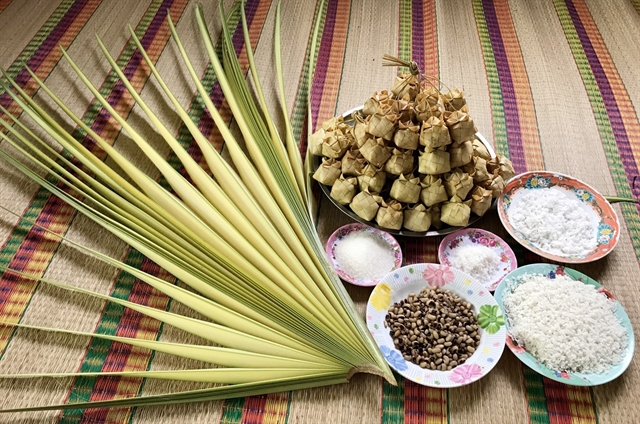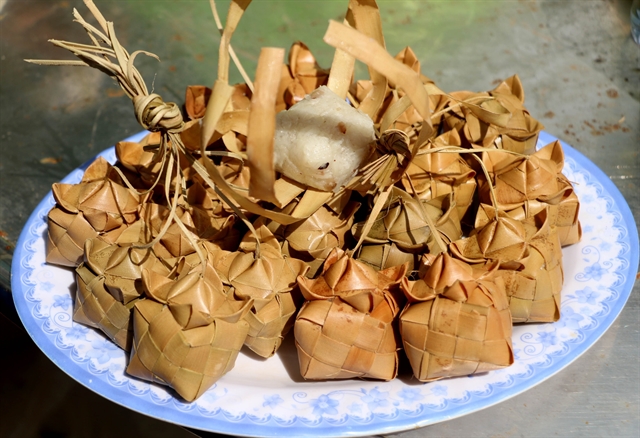Traditional delicacy represents wealth of Khmer ethnic minority people
Ka Tum, in Khmer language means “pomegranate” or "wrapped inside", is a kind of dumpling wrapped by leaves of thot not (Asian palmyra palm) that looks like pomegranate fruit.
 |
| The dumpling’s ingredients include sticky rice, white bean, coconut, sugar and salt. Leaves of Asian palmyra palm are used to form the dumpling’s cover. |
The delicacy has a meaning of wealth and prosperity that is always made during traditional holidays of Khmer people in the southern province of An Giang like Chol Chnam Thmay, Sen Dolta, and Ok om bok.
The dumpling is now popular only in O Lam, Tri Ton District of the province.
The cover of the dumpling is knitted sophisticatedly using young leaves of Asian palmyra palm. The very complex cover has resulted in very few who can make the dumpling, as it requires rather a long time to learn how to make properly.
Neang Phuong, who resides in the province's Phuoc Loc Village, is the only one offering the dumpling in the whole region.
Taught by her mother when she was 16, Phuong has made the dumpling for 40 years.
Her dumpling won the Gold Medal at the annual Southern Folk Cake Festival in 2016. Her product has also been recorded in Việt Nam’s Record Book as the most sophisticated dumpling wrapped in leaves of Asian palmyra palm in Viet Nam.
 |
| The dumpling looks beautiful like a pomegranate with a flower on top. |
The leaves of Asian palmyra palm are popular in An Giang Province. Young leaves are used as they are more flexible and easier to fold than old ones. Besides, the light green colour of young leaves makes the dumpling more attractive.
The leaves are knitted into a shape of a pomegranate with a flower on top. It takes 15-30 minutes for a dumpling maker to knit the cover for the dumpling, which is the most time-consuming stage in the whole dumpling making process.
The dumpling inside is made of sticky rice, white bean, coconut, salt and sugar.
The sticky rice is the Chon Ho genre raised by Khmer people for six months and has a special fragrance. Yet now the genre is more scarce, so they have replaced it with normal sticky rice.
The sticky rice is soaked overnight before being mixed with white bean, coconut milk, mashed coconut, some salt and sugar. The whole mixture is put inside through a small hole in the cover and then the maker ties up the hole.
The dumpling is then boiled in water for 45-60 minutes. A professional dumpling maker like Phuong needs a day to make 100 dumplings.
The final dumpling will have a clear, yellow colour. Each bunch has ten small dumplings. The inside is sticky, soft, fat and has a natural fragrance of coconut and the palm’s leaves.
Phuong has handed down the dumpling making skills to her family members and locals who want to learn. She wants to diversify the inside with more kinds of ingredients to make it more tasty and eye-catching.
Source: VNS